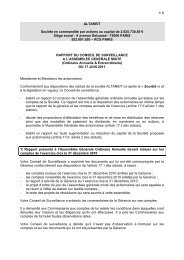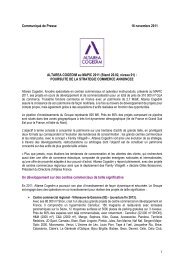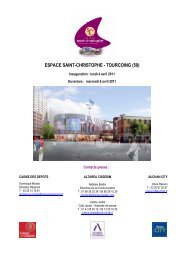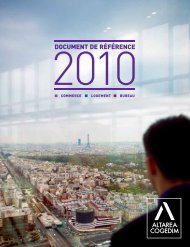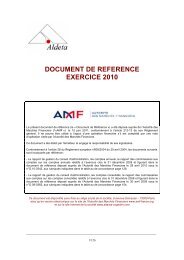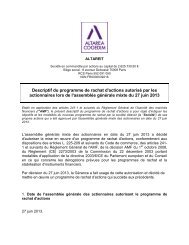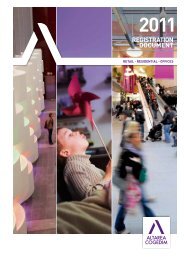Annual report 2008 - Altarea Cogedim
Annual report 2008 - Altarea Cogedim
Annual report 2008 - Altarea Cogedim
Create successful ePaper yourself
Turn your PDF publications into a flip-book with our unique Google optimized e-Paper software.
1999 concerning the overhaul of French GAAP in 1982.<br />
The general accounting conventions used observe the<br />
principles of conservatism and consistency, with the<br />
financial statements being drawn up on a going concern<br />
basis, in accordance with the accrual principle and the<br />
general rules for preparing and presenting annual financial<br />
statements.<br />
Elements in the financial statements are measured at<br />
historical cost.<br />
Unless stated otherwise, the annual financial statements<br />
were drawn up and presented in thousands of euros.<br />
The following sections describe the Company’s primary<br />
accounting methods.<br />
Intangible assets<br />
Intangible assets are measured initially at acquisition cost.<br />
They may be written down when their carrying amount<br />
differs significantly from their value in use, as defined in<br />
French GAAP.<br />
Software acquired is usually amortised on a straight-line<br />
basis over 3 years.<br />
Property, plant and equipment<br />
Gross value of property<br />
Property is initially recorded at acquisition cost, which for<br />
contributed property is the contribution value excluding<br />
purchase costs and for new property is the construction or<br />
refurbishment cost. Purchase costs (transfer duties, expert<br />
fees, commissions, and stamp duties) are recognised as<br />
expenses.<br />
The Company uses the component method to calculate<br />
the useful lives of its property, as recommended by the<br />
French Federation of Property and Land Companies (FSIF).<br />
The useful life of each property component is given in the<br />
following table:<br />
Components Useful lives<br />
(Shopping centres)<br />
Useful lives<br />
(business premises)<br />
Structural work (structures,<br />
road and utilities works)<br />
50 years 30 years<br />
Facades, seals 25 years 30 years<br />
Technical equipment 20 years 20 years<br />
Fixtures and fittings 15 years 10 years<br />
Property depreciation<br />
Property depreciation is calculated based on the following:<br />
• the useful lives of the components. If the components have<br />
different useful lives, each component whose cost makes<br />
up a significant portion of the total cost is depreciated<br />
separately over its individual useful life; and<br />
• the property’s acquisition cost less its residual value, where<br />
the residual value is the estimated amount the Company<br />
would receive if it sold the property at current market prices,<br />
less any selling expenses, assuming the property was in the<br />
condition expected at the end of its useful life. In the light<br />
of the long useful lives used by the company, the residual<br />
values of all components are assumed to be zero.<br />
Provision for property impairment<br />
The Company’s property is appraised twice per year by an<br />
independent appraiser, Cushman & Wakefield, to determine<br />
its market value.<br />
Because the Company recognises purchase costs as<br />
expenses, the current value of its property is essentially<br />
equal to the appraisal value excluding fees, after taking into<br />
account any probable near-term developments that are not<br />
included in the appraisal.<br />
The Company recognises an impairment loss for the<br />
difference whenever the current value of a property asset<br />
falls significantly below its carrying amount.<br />
Other property, plant and equipment<br />
Other property, plant, and equipment is initially recorded at<br />
acquisition cost.<br />
Transport, office, and computer equipment is depreciated<br />
over five years.<br />
Financial assets<br />
The Company’s financial assets include shares held in<br />
subsidiaries and participating interests, as well as loans and<br />
advances to the Company’s indirect participating interests.<br />
Financial assets are measured at acquisition cost or<br />
contribution value.<br />
Financial assets may be impaired where their carrying<br />
amount falls substantially below their value in use as defined<br />
in French GAAP, where value in use is based on several<br />
criteria, such as equity, earnings and earnings outlook, longterm<br />
growth prospects and economic climate. The market<br />
value of assets held by subsidiaries and sub-subsidiaries is<br />
taken into account.<br />
Receivables<br />
The Company’s receivables are carried at nominal value.<br />
They consist of group receivables and trade receivables<br />
from shopping centres.<br />
An allowance for impairment of receivables is set aside<br />
when there is evidence that the Company will not be able<br />
to collect all amounts due. Allowances are calculated<br />
separately for each customer after subtracting the security<br />
deposit and accounting for the length that the receivable<br />
has remained outstanding, any progress made on collection<br />
efforts, and any guarantees that have been received.<br />
59



